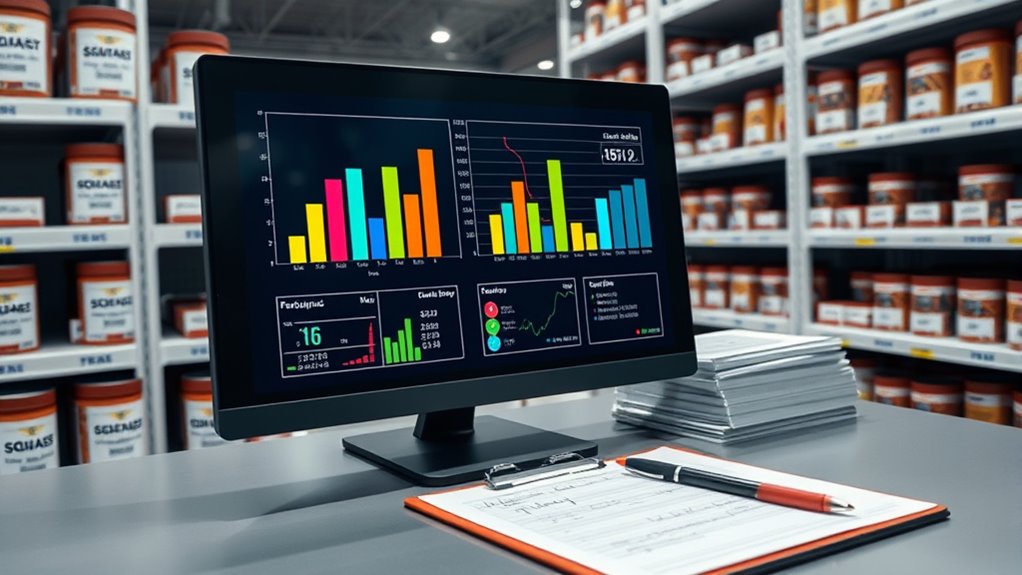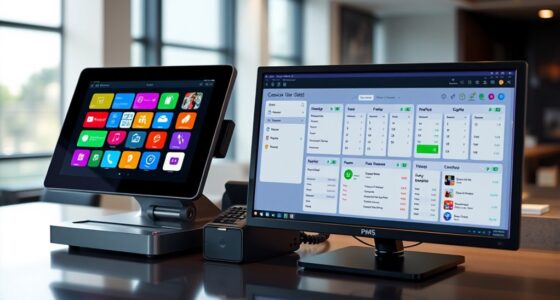To set inventory minimums or par levels, you need to analyze your usage patterns, seasonal demand changes, supplier lead times, and storage capacity. Regularly monitor your stock to adjust these levels as needed, ensuring you avoid overstocking or shortages. Properly managed par levels keep your inventory efficient and responsive to actual demand. If you want to learn how to fine-tune these levels for ideal results, there’s more to explore below.
Key Takeaways
- Par levels represent ideal stock quantities to meet demand without overstocking or shortages.
- Set par levels based on usage patterns, lead times, seasonal trends, and storage capacity.
- Adjust par levels regularly by analyzing sales data and demand fluctuations for accuracy.
- Use inventory management tools and alerts to monitor stock levels and notify when reordering is needed.
- Regularly review and revise par levels to reflect changes in demand, market conditions, or supplier reliability.
Understanding the Concept of Par Levels

Understanding the concept of par levels is essential for managing inventory efficiently. Par levels represent the ideal quantity of an item you should keep on hand to meet demand without overstocking. Setting these levels involves analyzing how often items are used and how quickly they are replenished. When your inventory drops below the par level, it signals the need to reorder. Conversely, maintaining stock above this point can tie up cash and storage space unnecessarily. Par levels are not static; they should be adjusted based on factors like seasonal fluctuations, supplier lead times, and changes in demand. Additionally, understanding digital literacy can help streamline inventory management processes through the use of technology and digital tools. Establishing accurate par levels helps you balance inventory costs with customer service, ensuring you have what you need without excess or shortages.
Benefits of Establishing Proper Inventory Minimums

Establishing proper inventory minimums offers significant advantages for managing your stock effectively. It helps prevent stockouts by ensuring essential items are always available, reducing delays and customer dissatisfaction. It also minimizes overstocking, which ties up capital and increases storage costs. With clear minimums, you can streamline ordering processes and improve inventory accuracy. Incorporating diversification strategies can further optimize your inventory management by balancing stock levels across different product categories.
Factors to Consider When Setting Par Levels

When setting your par levels, you need to analyze how frequently items are used to prevent shortages or overstocking. It’s also important to evaluate lead times so you can order supplies in time, avoiding delays. Additionally, consider your storage space to make certain your inventory levels fit comfortably without cluttering your facility. Incorporating mindful decluttering strategies can help maintain an organized storage area that supports efficient inventory management.
Usage Patterns Analysis
Have you ever wondered how usage patterns influence the setting of appropriate par levels? Your goal is to match inventory with actual demand, avoiding shortages or excess. To do this effectively, consider these key factors:
- Frequency of Usage: Track how often items are used daily or weekly to identify high- and low-turnover products.
- Seasonal Fluctuations: Recognize seasonal trends that cause spikes or dips in usage, adjusting par levels accordingly.
- Order Variability: Monitor how often and in what quantities usage varies to prevent stockouts during unpredictable periods.
- Market Volatility: Be aware that fluctuations in precious metals prices can influence inventory decisions, especially for gold-related products. Market volatility can impact how much stock you need to keep on hand to respond to changing market conditions.
Analyzing these patterns helps you set realistic and efficient par levels, ensuring you maintain enough stock without overstocking. This insight allows you to optimize inventory, reduce waste, and improve your overall supply management.
Lead Time Evaluation
Understanding lead time is essential when setting par levels because it directly impacts how quickly inventory needs to be replenished. If lead times are longer, you’ll need higher par levels to prevent stockouts. Shorter lead times allow for lower minimums, reducing excess inventory. Consider supplier reliability, order processing times, and transportation delays. Additionally, vehicle performance modifications can influence how often spare parts or accessories are needed, affecting inventory planning.
Storage Space Management
Effective storage space management is essential when setting par levels because it influences how much inventory you can hold without clutter or waste. You need to assess your storage area’s size and organization to optimize inventory levels. Consider these three factors:
- Available Space: Know the size of your storage area to prevent overpacking and ensure easy access.
- Storage Layout: Arrange shelves and bins efficiently to maximize capacity and minimize retrieval time.
- Inventory Turnover: Higher turnover means less storage needed; adjust par levels accordingly to avoid excess stock.
Analyzing Historical Usage Data

Why is analyzing historical usage data essential for setting accurate par levels? Because it reveals patterns in how much inventory you typically use over time, helping you avoid shortages or overstocking. By reviewing past consumption, you can identify the average demand during different periods, such as busy or slow days. This process can also incorporate seasonal variations to refine your inventory management. Tracking usage also highlights trends, like increasing or decreasing demand, so you can adjust your minimums accordingly. Without this data, you risk setting arbitrary par levels that don’t match actual usage, leading to inefficiencies. Analyzing historical data provides a solid foundation for creating inventory minimums that support smooth operations and cost control.
Adjusting Par Levels for Seasonal Fluctuations

Seasonal fluctuations can substantially impact your inventory needs, making it essential to guarantee your par levels accordingly. During busy seasons, you might need to increase your minimum stock to prevent shortages, while off-peak times call for reductions to avoid overstocking. To effectively adjust, consider these steps:
- Track seasonal sales trends to identify peaks and dips in demand.
- Increase par levels during high-demand periods to ensure sufficient supply.
- Reduce par levels when demand drops, preventing excess inventory.
- Being aware of toilet maintenance and common issues can help anticipate supply needs for replacement parts and cleaning supplies during different seasons.
Calculating Par Levels Using Lead Times

Calculating par levels using lead times involves determining how long it takes to replenish your inventory and adjusting your stock accordingly. First, identify the supplier’s lead time—how many days or weeks it takes for an order to arrive after placing it. Next, analyze your average daily usage of each item. Multiply your daily usage by the lead time to find the amount needed to cover your inventory during that period. Add safety stock to this number to account for delays or unexpected demand. This sum becomes your par level for each item, ensuring you maintain enough inventory to meet demand without overstocking. Regularly review and update these calculations as lead times or consumption rates change. Transparency in your inventory management practices, including affiliate relationships, can also help maintain accurate stock levels.
Implementing Par Levels in Your Inventory System

Implementing par levels in your inventory system involves setting up clear, standardized thresholds for each item based on your calculated par levels. First, input these thresholds into your inventory management software or manual tracking system. Next, label each item with its respective par level to guarantee visibility. Finally, establish procedures for restocking whenever stock dips below the set minimum. Incorporating standardized thresholds can improve the accuracy of your inventory control. Here’s what you’ll do:
- Assign a specific par level to every item in your inventory.
- Configure your system to alert you when stock falls below the threshold.
- Train staff to recognize and act on these alerts promptly.
Monitoring and Revising Par Levels Over Time

Monitoring and revising your par levels regularly is essential to guarantee your inventory remains efficient and responsive to changing demands. Track your usage patterns and sales data consistently to identify trends and fluctuations. If certain items are consistently overstocked or understocked, adjust your par levels accordingly. Don’t wait until stockouts or excess inventory occur; proactive adjustments help optimize cash flow and storage space. Review your par levels at least monthly or after significant changes in demand, seasonality, or supplier availability. Keep detailed records of your revisions and the rationale behind them. This ongoing process ensures your inventory stays aligned with actual needs, reduces waste, and improves overall efficiency. Staying vigilant allows you to respond swiftly to shifts in your operational environment.
Common Mistakes to Avoid When Setting Par Levels

Setting par levels without careful consideration can lead to costly mistakes that disrupt your operations. One common error is setting them too high, which causes excess inventory and ties up cash. Conversely, setting them too low can result in stockouts, delaying service or production. Another mistake is ignoring actual usage patterns; relying on guesswork instead of data leads to inaccurate par levels. Additionally, failing to review and adjust par levels regularly prevents you from adapting to changing demand or seasonal fluctuations. To avoid these pitfalls, base your par levels on historical data, monitor trends consistently, and adjust as needed. Being precise and proactive ensures your inventory remains optimized, saving you money and maintaining smooth operations. Incorporating accurate tuning procedures from vehicle modifications can also help optimize inventory for automotive parts and accessories.
Tools and Software to Help Manage Par Levels

Using the right tools and software can considerably streamline managing your par levels, guaranteeing accuracy and efficiency. Inventory management software like BevSpot, Upserve, or MarketMan helps you track stock levels in real-time, automatically updating par quantities as sales occur. These platforms often include forecasting features that analyze sales patterns to suggest ideal par levels. Barcoding systems and scanners speed up stock counts, reducing errors and saving time. Cloud-based tools enable remote monitoring, so you can adjust par levels from anywhere. Additionally, integrated POS systems can automatically update inventory when sales happen, keeping your par levels accurate without manual input. Investing in these tools saves you effort, minimizes mistakes, and guarantees your stock levels align with actual demand.
Frequently Asked Questions
How Often Should Par Levels Be Reviewed and Updated?
You should review and update your inventory minimums regularly to keep your stock levels accurate and prevent shortages or excess. Typically, it’s best to check your par levels every three to six months, or whenever there’s a significant change in demand, supplier issues, or business operations. Regular reviews help guarantee your inventory stays aligned with current needs, saving you time and money while maintaining ideal stock levels.
What Are Signs That My Par Levels Are Set Too High or Low?
Imagine your restaurant often runs out of popular ingredients like fresh basil. If your inventory levels are consistently low, your par levels might be set too high, leading to waste. Conversely, if you rarely run out but have excess stock, your par levels could be too high, tying up money and space. Signs include frequent shortages or surplus, which indicate you should adjust your par levels for ideal inventory management.
How Do Par Levels Impact Overall Inventory Turnover?
Your par levels directly influence your inventory turnover rate. If they’re too high, you’ll hold excess stock, leading to slower turnover and increased storage costs. Conversely, if your par levels are too low, you’ll risk stockouts, which can disrupt operations and cause customer dissatisfaction. Properly set par levels help you maintain a balanced inventory, ensuring quick turnover, reducing waste, and optimizing your overall inventory management efficiency.
Can Par Levels Be Different for Various Product Categories?
You might think all product categories should have the same inventory minimums, but they actually vary based on usage and demand. For example, perishable items need higher par levels to prevent stockouts, while slow-moving products can have lower levels. Setting different par levels helps you balance stock availability with storage costs, ensuring you meet customer needs without overstocking. This tailored approach optimizes your inventory management effectively.
What Training Is Needed for Staff to Manage Par Levels Effectively?
To manage par levels effectively, you need proper training for your staff. They should understand how to monitor inventory, identify when stock is low, and adjust par levels as needed. Provide hands-on instruction on using inventory management systems, recognizing product trends, and communicating with suppliers. Regular refresher courses help ensure staff stay knowledgeable. By empowering your team with this training, you keep stock levels ideal and avoid shortages or excess.
Conclusion
Did you know that businesses with well-maintained par levels see up to 20% reduction in waste and stockouts? By understanding and setting accurate inventory minimums, you can streamline operations, save money, and improve customer satisfaction. Regularly monitor and adjust your par levels to keep up with seasonal changes and usage trends. Taking control of your inventory management today guarantees smoother operations and long-term success—don’t leave your stock to chance.









